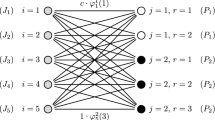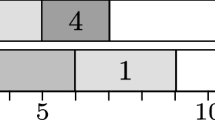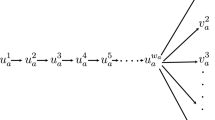Abstract
We characterize a nontrivial special case with a polynomial-time algorithm for a well-known parallel machine scheduling problem with precedence constraints, with a fixed number of machines, and with tasks of unit length. The special case is related to instances with given maximum path length and maximum degree of the task precedence graph. The method is based on the observation that the number of tasks is either small and bounded by a constant depending on the maximum path length and maximum degree, or alternatively, the number of tasks is large, giving a “dense” schedule.
Similar content being viewed by others
Explore related subjects
Discover the latest articles, news and stories from top researchers in related subjects.References
Cormen T. H., C. E. Leiserson, and R. L. Rivest, Introduction to Algorithms. MIT Press, Cambridge, MA, 1990.
Graham R. L., D. E. Knuth, and O. Patashnik, Concrete Mathematics: A Foundation for Computer Science, Addison-Wesley, Reading, MA, 1989.
Pinedo M., Scheduling: Theory, Algorithms, and Systems, Prentice Hall Englewood Cliffs, NJ, 1995.
Lenstra J. K. and Rinnooy Kan A. H. G., “Complexity of scheduling under precedence constraints,” Operations Research, 26, 23–35 (1987).
McNaughton R., “Scheduling with deadlines and loss functions,” Management Science, 6, 1–12 (1959).
Woeginger G. J., “Open problems in the theory of scheduling,” Bulletin of the European Association for Theoretical Computer Science, 76, 67–83 (2002).
Author information
Authors and Affiliations
Corresponding author
Rights and permissions
About this article
Cite this article
Aho, I., Mäkinen, E. On a parallel machine scheduling problem with precedence constraints. J Sched 9, 493–495 (2006). https://doi.org/10.1007/s10951-006-8499-4
Issue Date:
DOI: https://doi.org/10.1007/s10951-006-8499-4




